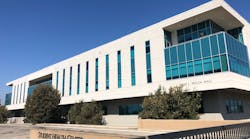There’s a lot of buzz about luminaire level lighting controls (LLLC) – and for good reason. LLLC technology enables greater control over a building’s lighting system, all the way down to the individual fixture level, resulting in optimized lighting for the space. Compared to other lighting control systems, which may simply be turned on or off with a switch or on a schedule, these advanced lighting control systems allow building operators and managers to greatly reduce annual energy costs through capabilities like daylight harvesting and high-end trim. One of the most promising features of the technology, however, is that the fixture-level sensors and connectivity LLLC allow for integration with other building systems to achieve even greater energy cost savings.
A recently completed research project funded by the California Energy Commission and led by New Buildings Institute (NBI), Leading in Los Angeles, sought to develop, test, and pilot a building retrofit package aimed at reducing total building annual energy consumption by 20% or more. The innovative package combines LEDs, advanced lighting controls, automated interior shades, and minor retro-commissioning of the heating, air-conditioning, and ventilation system that all work together to create an energy-efficient and comfortable space.
Here’s how the automated shades work: In order to give occupants both natural light and views to the outside without excess heat gain or glare, the shading system is split into two parts – an upper section and a lower one. The upper portion covers approximately a third of the window and consists of horizontal blinds that open and close as needed to reflect light onto the ceiling while preventing direct sunlight at the occupant level. The bottom portion, which covers the “view” portion of the window, is a roller shade that manages glare and heat gain while still providing outside views when in the closed position. Users can adjust the positioning of the roller shades via fixed buttons, a smartphone app, or web browser, and the angle of the blinds and the position of the roller shade are both remotely controllable.
The package really shines when working with the LLLC system: When the blinds reflect daylight deep into the building, the individually controlled light fixtures dim or even cut power to the LEDs altogether if there is sufficient light in the space to meet the programmable set points, all without occupant intervention. This allows for persistent lighting energy savings while empowering occupants to remotely control the shades in their space at the touch of a button.
The benefits of LLLC extend beyond lighting energy savings, however. At a Leading in Los Angeles pilot demonstration site, an engaged energy manager at the Welch Hall building on the California State University Dominguez Hills Campus is taking full advantage of integrating the built-in occupancy sensors of the LLLC system with the HVAC controls. In order to conserve energy, the HVAC system can run on “unoccupied mode” if spaces are unoccupied as determined by the lighting system. In this energy saving mode, the ventilation rates and set points are dialed back to minimum requirements to avoid over-conditioning empty rooms. This integrated system approach, through the LLLC sensor, puts more granular information about space use and occupant lighting preferences in the hands of the building operator through their building automation or energy information system. Here, the energy and building managers can assure lighting and HVAC defaults are optimized for occupants and energy savings.
Since the installation of the retrofit in late 2020, lighting energy use is down 35%, while whole building energy use is down 26%, thanks to the combination of lighting and HVAC savings. The non-energy benefits are significant as well: occupants at the demonstration sites have praised the customizability of their lighting levels down to the fixture level, as well as the comfortable and inviting space created by the automated shades. Teachers in particular are able to manage glare in the classroom setting while maintaining daylight in the space.
It is important to consider the benefits of any retrofit in the context of the whole building’s occupant experience. Energy cost savings and financial payback are important when considering the investment, but non-energy benefits are too often undervalued or ignored altogether – such as overall occupant wellbeing, tenant attraction and retention, student performance, reduction in sick days, and a number of other benefits across all building types. These results demonstrate that automated shading and HVAC combined with LLLC technology offer valuable benefits to building occupants, building operators, and building owners alike.
Carbonnier is a project manager at New Buildings Institute focused on technical research and data analysis. He can be reached at [email protected].




